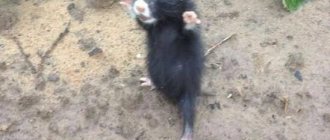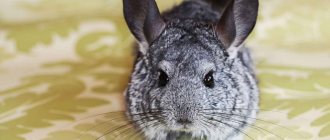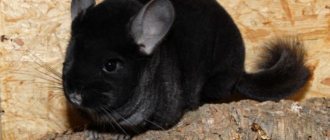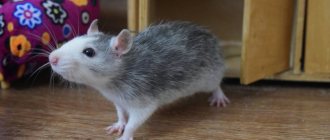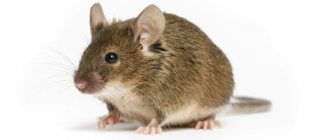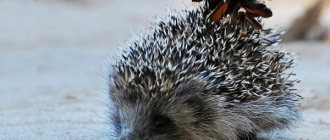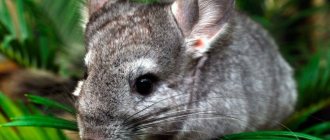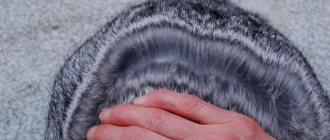Well, is it possible to remain indifferent to such an animal as a chinchilla? These miniature rodents with bright, beady eyes, a silky shiny coat and a fluffy tail, at first sight evoke sympathy and a desire to pick up the charming creature.
Unfortunately, not everyone loves the chinchilla. Lovers of natural fur consider these creatures only as a fashionable fur coat, and there are many mercantile people who rush to satisfy the whims of rich ladies. Spontaneous hunting for chinchillas has already led to the fact that there are almost no chinchillas left in the natural environment, and according to the latest data, there are hardly 10 thousand individuals in the wild.
These beautiful creatures are listed in the Red Book as an endangered species, but it is unlikely that animal activists will be able to save chinchillas from complete extinction, and perhaps the next generation will only see the furry rodents in pet stores or, in general, in pictures of wildlife magazines.
A brief excursion into the history of the origin of chinchillas
These beautiful rodents resemble hares, squirrels, and rats at the same time. Surprisingly, chinchillas have nothing in common with the above animals except external resemblance, and their closest relative is... the porcupine. There is also a version that chinchillas have a common ancestor with viscachas - long-tailed rodents that also live in the Andean mountains.
Chinchilla in its natural environment
Scientists believe that the genus of these rodents has ancient origins, and their age is more than 40 thousand years. They base their judgments on the fact that the remains of an unknown prehistoric animal were found in the Cordillera, the bones of which are very similar to the anatomical structure of the body of modern chinchillas.
The Inca tribes, whose empire stretched from Chile to Ecuador, have mined chinchilla skins for clothing and household items since time immemorial. Interestingly, they were not the first to pay attention to the valuable fur of these rodents. Before the arrival of the warlike Incas, the territories at the foot of the Andes belonged to the Chincha people, and it was from them that the conquerors adopted the tradition of hunting furry animals. By the way, it is believed that the name “chinchilla” itself comes from the name of the Chincha tribe, who sold their skins to all nearby settlements.
But the Indians were careful about nature, so chinchilla fishing was under the strict control of local priests, so the population of these animals was not threatened. The conquest of South America by Europeans was a real tragedy for furry creatures. Beginning in the 15th century, Spanish and Portuguese colonists exported from the New World not only gold and precious stones, but also beautiful chinchilla fur.
Unlike the Indian tribes, the Europeans, greedy for money, did not care at all about the safety of these animals, and killed them in the millions. The greed and gluttony of the invaders has led to the fact that within 4 centuries the number of chinchillas in the wild has fallen to catastrophic levels, and in some regions the animals have completely disappeared.
In the middle of the 19th century, the authorities of South American countries finally came to their senses and imposed a ban on chinchilla fishing. But by that time, rodents were already on the verge of extinction, and severe punishment for poaching could not stop lovers of easy money, so it was not possible to restore the chinchilla population in their natural habitat, and it is likely that in the near future these amazing creatures will be raised only in captivity.
Chinchilla protection
Nowadays, only in Chile can you find this animal living in the wild, but the number of these animals is constantly declining. Scientists have been able to roughly estimate that no more than 10 thousand individuals remain in nature. In this regard, in 2008, the chinchilla was listed in the International Red Book, under the status of “endangered species”.
Zoological specialists have repeatedly made attempts to resettle animals to other territories, but all these attempts have been in vain. The chinchilla refused to live in other, even more comfortable living conditions. The total number of these animals is decreasing due to some negative factors, such as environmental degradation and ongoing poaching.
Even in a nightmare one cannot dream that the populations of these animals have decreased from several tens of millions to several thousand. Unfortunately, it couldn't have happened without people. The chinchilla is a cute animal that does not show any aggression. Moreover, these are animals that can bring a person a lot of positive emotions. Being in captivity, these animals are able to keep company for any person. Unfortunately, man has never been able to become a true friend and defender of wildlife, despite the fact that he has every opportunity.
Where do chinchillas live in the wild?
The original homeland of these furry animals is South America, and their territory of residence is limited to three countries: Bolivia, Argentina and Peru. To be even more precise, chinchillas are distributed only in the highlands of the South American Andes, inhabiting inaccessible areas of rocks that are located at an altitude of 1000-4000 meters above sea level.
Chinchilla in his cave among the rocks
It would seem that in such an arid and harsh area as the northern Andes, it would be difficult for any animal to survive, but chinchillas have perfectly adapted to the local climate. These animals are not afraid of cold winds or frosts, and thanks to their thick, dense fur coat, they can easily withstand temperatures down to -30 degrees. And rocks and crevices serve as a reliable refuge for chinchillas from predators and a place where they can safely raise their offspring.
Mountain viscachas
The mountain viscacha genus is represented by three species:
- Southern,
- Patagonian,
- Northern.
Initially, the animals inhabited the mountainous regions of Peru, from where they eventually spread to the territory of Chile and other South American countries. Externally, mountain viscachas look more like large squirrels than chinchillas. They differ from other relatives in that they are often active during the daytime. They prefer to live at an altitude of four to five thousand meters, although individual populations are also found in lower mountainous areas. They prefer to settle on open rocks and choose places with dry and sparse vegetation. Most of the diet consists of lichens, mosses, succulents and roots.
Lifestyle of chinchillas in their natural environment
These are nocturnal animals; during the day they hide in holes and among stones, and become active only at dusk. Small rodents live in colonies numbering up to two to three dozen animals. True, in former times, when chinchillas had not yet become the object of mass hunting, the number of their groups could reach up to 100 individuals.
Chinchillas have an extremely flexible and plastic skeleton, so they can fit into even the narrowest crevices. And thanks to their large black eyes and sensitive whiskers, these animals are excellent at navigating in the dark.
Description of the rodent
Chinchilla – photo
– Advertising –
The chinchilla has a round head on a short neck. Body length is from 22 to 38 cm, tail length is 10-17 cm, it is covered with hard guard hairs. The eyes are large, the ears are round, 5-6 cm long, the whiskers are 8-10 cm long. The hind legs are four-toed, twice as long as the front five-toed ones, which allows the rodent to make high jumps. The auricles have special membranes that cover the ears during sand baths.
The thick and warm fur of chinchillas is necessary for the animals to survive in the cold mountain climate. This is one of the densest types of fur in animals: there are more than 25,000 hairs per 1 cm2 of skin. 60-80 of them grow from each hair follicle. Chinchillas do not have coarse guard hairs. Parasites cannot even live in such dense fur. Chinchillas do not have sweat or sebaceous glands; their fur gets wet in water and the chinchilla is not even able to stay on the surface. To get rid of moisture, remove lost hair and clean the fur of chinchillas, they take baths made from volcanic ash and fine dust and sand.
What do chinchillas eat?
In the wild, the diet of furry animals is quite meager and monotonous. They mainly eat plant foods: grasses, bush twigs, seeds and lichens. Chinchillas do not disdain the roots and fruits of plants; they willingly eat the bark of young trees. There is little precipitation in the highlands of the Andes, there are almost no natural bodies of water, so rodents replenish their water balance with succulent shoots of cacti. Chinchillas also love to eat insects, various beetles and their larvae.
chinchilla eats a piece of apple
What to feed your chinchilla?
Chinchillas are vegetarians, so when choosing food, you should take this feature of the animal into account. The chinchilla needs to be fed with special food. Pet stores have a huge range of granulated food. This food contains essential vitamins and minerals.
In addition to food, you must feed your chinchilla hay. You can prepare it yourself; for this you need to collect clover, dandelions and herbs. But you can also buy hay at a pet store. When purchasing, pay attention to the quality of the hay; it should be dry, clean, free of unpleasant odor and mold. A special hay feeder should be placed in the cage.
The chinchilla should be fed once a day. Food and water should always be fresh. Water should be given filtered or boiled. There should always be a special stone in the cage for grinding teeth, which can be purchased at any pet store.
Pelleted dry food and hay are the best diets for chinchillas. As a top dressing, you can give your chinchilla flax seeds, corn grains, dandelion leaves, birch, willow, raspberry, apple, currant and linden branches. But under no circumstances give branches of cherry, oak and coniferous trees. You should not feed your chinchilla many fresh vegetables and fruits, as this can lead to stomach problems.
Chinchillas especially love raisins, dried apricots, dried apples, pears, cherries and rose hips. But such treats should not be given often. Also be careful with nuts and seeds, they should be given in very limited quantities and only raw; fried grains are contraindicated for the animal. You should not give your chinchilla food from your own table (bread, cookies, etc.).
Natural enemies
Large predators are not found in chinchillas' habitats, but they still have plenty of enemies. First of all, these are foxes that set up ambushes near the burrows of furry rodents, and patiently wait for the prey to carelessly emerge from its hiding place. Snakes often sneak into the gorges favored by chinchillas, and owls and eagle owls lie in wait for them in the pre-dawn hours. Taira is also not averse to hunting them - a predator from the mustelid family, whose small size allows it to deftly penetrate into the chinchillas’ lair, grabbing the first animal it comes across.
Camouflage color helps chinchillas successfully hide from predators
But the most dangerous enemy for these amazing creatures was and remains man, who, because of their beautiful fur, almost completely exterminated chinchillas in their natural habitat.
Plains chinchillas
Lowland viscachas are a genus of chinchillas that include two species. The southern Peruvian viscacha became extinct several centuries ago, and the lowland viscacha lives in the low-mountain regions of the Gran Chaco savannah. These are the largest representatives of their family. The weight of an adult can reach seven kilograms, and the length of the body, including the tail, often reaches a meter. In addition to their large size, viscachas are distinguished by their craving for shiny objects: pebbles, metal products and jewelry, bright bird feathers and even animal bones. The home of a rodent can be detected precisely by such objects lying near the entrance.
Social structure and reproduction of chinchillas
As already mentioned, furry animals lead a collective lifestyle, and matriarchy reigns in their community. Female chinchillas are larger than males, and it is they who make all the important decisions: where the flock will settle, when to leave the shelter, and how far to go in search of food. Interesting fact: the female also selects several sentries every night, who, while the rest of the family is feeding, must monitor the environment and, in case of danger, sound an alarm.
Chinchilla family
In difficult times for the colony, when there is not enough food, females have the right to expel a couple of males from the colony or even kill them in order to give the entire colony a chance to survive.
Chinchillas are monogamous and form strong mating alliances for their entire life period. Females become sexually mature at the age of 6 months, and males are ready to mate at the ninth month of life. The duration of pregnancy is from 3 to 3.5 months, and females can bear offspring no more than three times a year.
In one litter there are from one to three babies, which are born covered with fur and with open eyes. Already in the second week of life, furry cubs begin to try plant foods, but for another two months they feed on mother’s milk.
Baby chinchillas
Elena
Ask a Question
Question to the expert
Please tell me how many years do chinchillas live?
In the wild, these animals live 18-20 years. And in captivity, their life expectancy ranges from 13 to 15 years.
Lifestyle
Little data on the life of these animals has been recorded, since the natural habitat of chinchillas is inaccessible for research. According to some reports, in nature they can live 20 years.
In the wild, individuals gather in colonies of ten to one hundred animals. But even in large flocks, chinchillas are divided into monogamous pairs. Females occupy a dominant position because they are larger and much more aggressive than males.
Animals are active at night and sleep during the day. The animals are adapted to a nocturnal and twilight lifestyle thanks to their large eyes with vertically located pupils.
During the waking period, the colony provides a kind of security. The sentinels are inspecting the area. At the slightest threat, they warn the flock, which defends itself from enemies or runs away depending on the size of the attacker. The animals climb steep cliffs at high speed thanks to their well-developed cerebellum.
The animals do not stock up on food for unfavorable days, but use the supplies of their neighbors - chinchilla rats. The required amount of food for both types of animals is no more than a tablespoon per day, so the savings accumulated by rats are quite enough.
Types of chinchillas
At the moment, only two species are included in the genus of these animals: the large short-tailed chinchilla and the small long-tailed chinchilla.
Large long-tailed chinchilla
Large, short-tailed chinchillas were once widespread throughout Peru, which is why they were also called Peruvian. These are large rodents with a short tail covered with stiff hairs and a light gray coat. Their luxurious light fur was a desirable prey for poachers, which led to the almost complete extermination of the animals. Now large chinchillas can still be found in the mountains of Argentina and Bolivia, but their population is on the verge of extinction, and is included in the registers of the International Union for Conservation of Nature.
Small short-tailed chinchilla
The small (or common) long-tailed chinchilla is a resident of the Chilean Andes, preferring to settle in the lowlands of high-mountain plateaus, which is why they got the name coastal. They differ from their short-tailed fellow creatures by their more modest dimensions, long, densely pubescent tail and dark color. In the wild, their numbers have also reached a critical point, but the subspecies of small chinchillas is bred on farms as a source of industrial fur, and in nurseries as pets.
Until the 19th century, there was another variety of these animals - the royal chinchilla. They were the largest representatives of the chinchilla genus, reaching the size of a hare, and possessing long, bluish-gray fur. The reason for their disappearance was uncontrolled hunting, and now the only specimen in the form of a stuffed animal is kept in the German Museum of Natural History.
Final table of chinchilla species according to user ratings
Long-tailed
0
Short-tailed
0
Chinchilla diseases
Chinchilla diseases are most often the result of improper care and poor nutrition. The most common problems are: gastrointestinal upset (usually due to low-quality or expired food, poor feeding habits or a monotonous diet), hair problems (the cause may be a lack of vitamins or skin parasites), obesity, bladder stones, conjunctivitis, periodontal disease , sunstroke or hypothermia.
If you have the slightest suspicion that your chinchilla has health problems, you should contact your veterinarian. It is extremely undesirable to delay visiting a doctor, because the sooner the problem is identified, the greater the chance of curing your pet.
Take care of your pets, take care of them and do not forget that we are responsible for those we have tamed. If you liked this article, subscribe to site updates to be the first to receive the most interesting and useful articles about animals.
Don’t forget to subscribe to updates on our website and join us on social networks (Vkontakte, Odnoklassniki, Instagram) so you don’t miss anything and always stay up to date with all the news!
Don't forget to share with your friends!
How chinchillas were domesticated
When the demand for the luxurious fur of these animals throughout the feast reached unprecedented proportions, many people began to think about raising chinchillas in captivity. But all attempts to domesticate furry creatures failed, because no one knew what conditions they needed for reproduction, or even how to properly maintain them. And only the American Matthias Chapman managed to successfully breed these animals and establish the first chinchilla farm.
Breeding chinchillas on a farm
It is noteworthy that initially Mr. Chapman did not have such a goal. He had never worked with animals, since he was a mining engineer, not a breeder, and did not even know about the existence of chinchillas. Matias was working in a mine in Chile, and one day a local Indian approached him with a strange animal in his arms. The interested engineer began asking the visitor about his pet, and he offered to buy the rodent. The American didn’t even hesitate, he really liked the fluffy animal, and without hesitation paid the Indian the required amount.
Chinchilla nutritional features
Chinchilla eats
Like other herbivorous rodents (for example, the spiny mouse), chinchillas feed on various plants, mainly cereals, as well as seeds, moss, lichens, shrubs, tree bark, and occasionally small insects. In captivity, chinchillas eat exclusively dried foods (for example, dried apples, carrots, hay, nettles and dandelion roots); special granules are used as the main food.
Keeping a chinchilla at home
The popularity of these creatures is associated not only with their beautiful appearance, but also with their unpretentiousness in home maintenance. Chinchillas do not need street walks, do not require constant attention from the owner, and, being very clean, they themselves take care of their luxurious fur coat.
Cell selection
Don't think that a chinchilla can live in an old aquarium or even in a shoebox! Any pet requires optimal living conditions, and furry rodents are no exception in this regard. Therefore, the first thing you should take care of before buying an animal is a spacious and comfortable home for the animal. The cage must be equipped with a feeder, drinking bowl, house and shelves.
There are two types of chinchilla cages:
- Metal. They are very popular among rodent owners, as they are relatively inexpensive and easy to clean. Among the disadvantages, it can be noted that leftover food, hay and filler granules will be scattered both near the cage and on the floor.
- Display cases. This is a more expensive option, which is a structure made of a wooden base, with walls made of fine mesh and glass. The advantage of such cages is good sound insulation, and the pet’s night fussing does not cause much inconvenience to the owners. The downside is that they are difficult to clean, and the wooden tray swells with moisture over time and absorbs unpleasant odors, so the display cases require periodic replacement.
If the chinchilla’s cage is small, then do not clutter it with unnecessary accessories: ladders, hammocks, tunnels. The rodent must move freely, having space for maneuvers and jumps.
Care
Caring for a small pet will not cause you much trouble; in fact, you will only have to spend a little time cleaning the cage. Change the hygienic filler every 2-3 days, wash the tray about once a week, and keep the feeder and drinker clean. Also regularly clean the accessories from your chinchilla’s home from dust and hair.
chinchilla takes a sand bath
Question to the expert
Is it possible to bathe a chinchilla in water?
Absolutely not! In the wild, these rodents clean their fur by bathing in volcanic ash, and when kept in captivity, they need special sand for bathing, which can be purchased at any pet store.
What and how to feed
Feeding chinchillas in captivity should be as close as possible to their diet in the natural environment. These are herbivorous animals, so the basis of their menu is cereals and hay. Industrial food for chinchillas is presented in the form of grain or granular mixtures, which, in addition to cereals, contain useful herbal supplements and minerals. The rodent is fed once a day, usually in the evening, pouring 2-3 tablespoons of food into a bowl.
Chinchilla eats a treat
Chinchillas also need to be given hay daily, which improves the animal’s digestion, and fed with fresh herbs and tree branches. As for treats, pets are sometimes pampered with dried fruits (raisins, dried apricots, dates) and almonds, peanuts or raw pumpkin seeds.
In nature, chinchillas do not drink water, receiving the necessary moisture from cacti and mosses. But at home, your pet’s cage should always have a drinking bowl with clean, fresh water.
One of the characteristics of chinchillas is that their teeth grow throughout their lives, and animals need to constantly grind them down. In nature, animals solve this problem with the help of tree bark or cobblestones, but in captivity they need a special sharpening stone-mineral.
Chinchilla: description
Until now, scientists are racking their brains over which animal is the ancestor of the chinchilla. As a result of archaeological finds in the Cordillera, scientists were able to familiarize themselves with prehistoric fossils, which in appearance are similar to a chinchilla, while the size of the prehistoric animal was much larger. Scientists have determined that the remains of this animal are at least 40 thousand years old, so we can assume that the chinchilla is a very ancient animal. It should also be recalled that the ancient Incas depicted these animals on rocks, since such images have survived to this day.
The Incas used the soft skins of these animals to make various items of clothing, although the Incas are not considered to be the first to be interested in the fur of these rodents. It is believed that the pioneers in this matter are the Chyncha Indians. Experts also suggest that the name “chinchilla” appeared thanks to this tribe, since the name of the tribe and the animal sounds almost the same.
The Incas valued the fur of this animal highly enough, so they constantly controlled its production so as not to harm the overall population of these animals. Unfortunately, at the end of the 15th century, when the Spaniards appeared on the mainland, the total number of these valuable animals began to decline sharply due to the ruthless hunting of these rodents. As a result, countries such as Chile, Bolivia and Argentina have legally banned the hunting of chinchillas, as well as their export. There are serious penalties for illegal hunting.
The chinchilla is a rodent of the chinchilla family of the same name.
There are two types of similar animals found in nature:
- Short-tailed (coastal) chinchilla.
- Long-tailed (mountain) chinchilla.
Mountain chinchillas prefer to live in mountainous areas, at altitudes of more than 2 thousand meters above sea level. This animal is distinguished by its large size and thicker coat. In addition, these animals have a hooked nose, which allows the animal to breathe cold mountain air without problems. Coastal chinchillas are somewhat smaller in size, while their tail and ears are somewhat longer compared to their mountain relatives.
Currently, experts believe that the mountain species of chinchillas has disappeared completely, although local residents of some mountainous regions of Chile and Argentina claim the opposite.
Interesting moment! The first chinchilla farm was organized by the American Matios Chapman. He is considered the first person to bring these animals to the United States. He began breeding chinchillas on a farm to supply clients with valuable fur for making some valuable items of clothing. After him, many began to practice breeding these animals on their farms.
Chinchilla - All about the rodent species | Type of rodent - Chinchilla
Appearance and features
Long-tailed chinchillas grow in length no more than 0.4 meters, with a tail length of no more than 0.2 meters. The ears are long, reaching 6 cm in height, rounded in shape. In comparison with the body, the head is considered large, while the muzzle is round in shape. The eyes are relatively large, but attractive, with vertical pupils. The whiskers (vibrissae) reach a length of about 10 cm. With the help of these organs, the animals easily navigate in the dark. Adults weigh no more than 1 kilogram, while males are somewhat smaller than females.
The fur of the animals is very fluffy, soft and pleasant to the touch. The exception is the tail, which is covered with stiff bristles. The main color is gray-blue (ashy), while the belly area is painted in light milky shades. Although there are individuals of other colors, this is rather an exception to the rule.
There are 20 teeth in a chinchilla's mouth, 16 of which are molars and grow throughout life. Chinchillas, compared to other types of rodents, are considered long-livers, as they can live for almost 2 decades. The chinchilla has small limbs, with the front ones armed with 5 fingers, and the rear ones with 4. With the help of longer hind limbs, the animals make long jumps. Thanks to a well-developed cerebellum, the animals have simply unique coordination, which allows them to conquer mountainous territories without any problems.
This rodent is interesting because its skeleton tends to shrink in certain, especially threatening situations. In case of any threat, this animal easily penetrates the smallest crevice. Another unique feature of the chinchilla is the fact that the animal practically does not sweat, since it does not have sweat glands. This means that there is no odor coming from this animal.
Where do they live?
The only habitat in our time is associated with South America, or more precisely, with the Cordillera and Andes mountain ranges. Animals are found in Argentina and Venezuela. The element of chinchillas is the highlands of the Andes, at altitudes up to 3 kilometers.
These small animals easily withstand the spartan harsh conditions when cold winds blow throughout the year. In summer, the ambient temperature does not exceed +23 degrees, and in winter there are frosts down to -35 degrees. In such conditions there is practically no precipitation, so chinchillas do not like water treatments. They clean their fur by bathing in the sand. The chinchilla's coat is poorly resistant to moisture.
A chinchilla's nest can be found in various crevices, among rock piles, and in small caves. Often, the animals themselves dig holes in order to form a shelter for themselves, hiding in it from various enemies. Much more often they use the burrows of other animals as their shelters. To see with your own eyes a chinchilla living in natural conditions, you will have to visit Chile. In other places and territories of other countries, the animal is so small in number that it is almost impossible to find it in nature. Even in Chile, the populations of these animals are under threat.
What do they eat?
The basis of the chinchilla's diet is plant foods, which are not very diverse in mountainous areas.
Chinchilla eats:
- Various herbs.
- Small bushes.
- Cacti.
- Mosses and lichens.
Animals replenish their body's moisture through dew and cacti, which are characterized by containing large amounts of moisture. These animals feed on the bark and roots of various plants, as well as their fruits. Their diet also includes various insects. When kept in captivity, the diet of these animals is much more varied, since the owners of these animals purchase special food. As food, the animal can be given fresh grass, as well as various vegetables, berries and fruits. They will happily chew on a crust of bread, dried fruits and nuts. These rodents eat hay in large quantities. You can safely feed chinchillas what hares or guinea pigs eat.
Living in natural conditions, these animals do not experience problems with the digestive system, despite the fact that the animals mainly feed on green vegetation. This is due to the fact that many plants contain tannins, which help animals with the functioning of the digestive system. Chinchilla rats live next to chinchillas and stock up on food for future use. Chinchillas often use these supplies, leaving their neighbors without food.
Behavior and lifestyle
Since there are very few of these animals left in natural conditions, very little is known about their life activities. In this regard, all observations were carried out in captivity. It was possible to establish that chinchillas prefer to lead a collective lifestyle. Each flock can consist of 5 pairs of animals or more. Group activity allows animals to more successfully resist external negative influences. Each flock has an individual that monitors the living space while the rest of the family feeds. In the event of any threat, this animal gives a signal in the form of a whistle and the animals immediately hide in their shelters.
These rodents prefer to lead a crepuscular lifestyle, as they see perfectly both during the day and at night. During the daytime, the chinchilla tries not to leave its hiding places. With the help of long whiskers, animals are able to navigate perfectly in the dark, and also easily find food for themselves. Large ears also help the animal, since fine hearing allows it to react to any sounds in advance. A well-developed vestibular apparatus allows the animal to easily and quickly overcome any obstacles, which is very important in mountain conditions.
Important point! As a rule, the head of the chinchilla family is the female. In addition, she is large in size compared to the male.
In those natural places where such animals live, there is practically no rain. To cleanse their fur of various parasites or odors, animals have to “bathe” in volcanic sand. The peculiarity of these living creatures is that in case of danger, the chinchilla easily gets rid of its fur. When a predator manages to grab the animal’s fur with its teeth, a piece of it remains in the predator’s teeth, and in the meantime the chinchilla finds itself in its shelter.
The behavior of these pets does not contain aggression towards humans. Moreover, the animals are affectionate and good-natured. These animals are easily tamed, so they quickly get used to going to the tray. Despite this, the chinchilla has a very freedom-loving and independent disposition, so it is unlikely that it will be possible to force the animal to do what it does not like. They can be stubborn, but only bite on rare occasions. It is worth noting that each animal has its own personality.
What kind of animal is this Chinchilla? Is it worth purchasing it?
Social structure and reproduction
It was previously noted that chinchillas are social animals that form numerous groups. Pairs form once and for life, with the female occupying a dominant position in the family. Upon reaching 6 months of life, the female is ready to reproduce, while males become sexually mature at 9 months. A female can become pregnant several times a year.
The female carries her offspring for 3 and a half months. As a rule, the female gains excess weight, and closer to childbirth she becomes inactive. One or two cubs are born, although it happens that the female gives birth to 3 babies. When born, the cubs are not as helpless as compared to other types of rodents. Although the creatures are tiny, they are quite formed and practically do not differ from their parents. The body of small animals is covered with a layer of fluffy fur, teeth are formed in the mouth, and the eyes are open. In addition, the offspring can move.
The weight of the cubs depends on their number, so the babies can weigh from 30 to 70 grams. After just one week, they gradually begin to get used to plant foods, but almost until 2 months of age the female continues to feed them with her milk. Females are quite affectionate and caring mothers. Compared to other types of rodents, these animals do not have a high birth rate, and in 1 year a female can give birth to 3 cubs. If we talk about young females, their birth rate is even lower.
Natural enemies of chinchillas
These animals, which are practically unable to fend for themselves, have plenty of natural enemies. Experts believe that the fox is the most dangerous predator because it is quite patient. Although the fox cannot enter the chinchilla’s shelter, it can patiently wait for hours for its prey at the entrance. And yet, camouflage coloring works, as do excellent reactions, speed of movement and structural features of the skeleton, which allows the chinchilla to quickly penetrate narrow openings into which various predators cannot penetrate.
In addition to the fox, many other predatory animals, as well as birds of prey, which easily cope with their prey in open areas, do not mind having such a prey for dinner.
Important to remember! The chinchilla has plenty of enemies, but the main one is humans. These animals are still mercilessly destroyed today for their valuable fur, although hunting them in any form is prohibited.
Human activity leads to constant deterioration of the environment on our Planet, from which many animals suffer, and the chinchilla is no exception.
The main factors are:
- Constant soil contamination.
- Depletion of food supply.
- Global changes in the Earth's atmosphere.
The negative influence of man is due to the fact that man puts his own benefit first and does not think at all about the animals that inhabit our Planet, as well as about the vegetation that ensures the livelihoods of many animals.
Character and habits of chinchillas
Recommended by topic
Horse Rabbit Cow
In general, these animals can be characterized as friendly, peaceful and affectionate creatures. They are not aggressive, they do not have the habit of biting, even if a chinchilla is afraid of something, it will not actively defend itself, but will try to hide in a secluded place.
But each animal is individual, and furry pets are no exception in this regard. Among chinchillas, according to their temperament type, there are both phlegmatic and choleric, which means that their behavior has its own characteristics. Rodents with a phlegmatic character are more restrained and balanced, they sleep almost all day in their house, and they are not too active at night, preferring to slowly and calmly study their surroundings. Choleric chinchillas are distinguished by their inquisitive and active nature, they are interested in every subject, and they attentively react to any extraneous noise.
Chinchilla plays with a keychain
Whatever type of character a chinchilla has, remember that these are very timid animals. Therefore, do not play loud music in the room with your pet’s cage, and do not arrange loud family disputes or noisy parties near him.
How to tame a chinchilla?
It is better to get a chinchilla when the animal is no more than 2-3 months old. At this age, the animal quickly adapts to a new environment than older individuals. If you decide to get a chinchilla, remember that this is a nocturnal animal that will be active in the evening and at night. The first time after the animal appears in the house, give it a few days of rest so that it gets used to its new home.
Taming a chinchilla is not that easy. For the most part, chinchillas do not need much attention and communication with their owner. Therefore, a chinchilla should be tamed gradually. Try giving your pet a treat, open the cage door and hand the chinchilla something tasty. The pet will definitely take the treat from your hands, if not immediately, then after a while. The main thing is not to try to forcibly pick up the animal.
To tame a chinchilla you will need patience, calmness and a caring attitude. Soon the tamed animal will be safely in your arms or sitting on your shoulder. Remember that by nature the chinchilla is a gentle, timid creature and does not like loud noises. Be careful when handling your chinchilla and do not frighten it.
Games and physical activity
These are very playful and active animals that simply love to walk around the apartment. A chinchilla will never miss an opportunity to sneak out of its cage and go explore the world. And considering that this is a rodent, after such entertainment for your pet you will find chewed shoes, sofa upholstery and wires. Also, an animal, frightened by a loud sound, can hide under a closet, from where it will be very difficult to get it out.
So experts do not recommend letting your chinchilla out of its cage, but rather purchasing a running wheel to satisfy its active needs. As a last resort, you can fence off an area on the floor in which your pet can frolic without causing damage to the apartment.
Chinchilla in a running wheel
Chinchilla behavior
Chinchilla at home
Chinchillas are colonial animals that lead an active nocturnal lifestyle. The rodent's skeleton is capable of compressing in a vertical plane, which allows it to fit into the narrowest vertical crevices in rocks. Large black eyes, long whiskers and large ears are also adaptations to a nocturnal lifestyle.
Historical reference
It is the beauty and “fluffiness” of the fur that is the problem of all chinchillas, whose history is replete with human violence. The ancient Indians began to take a closer look at their fur, deciding that the silvery skin would perfectly decorate their “outfit.” Following the Indians, the Incas began to hunt the animals, and then the Europeans. The Spaniards arrived and began catching rodents. Europeans were very impressed by the density and beauty of chinchilla fur. Since the animals had no fear or distrust of people, they could be caught with almost bare hands. The brutal and massive extermination of these animals began. Fur coats made from such rare and high-quality fur flowed into Europe in a huge stream. The first to try on the clothes were Spanish nobles and kings. And by the end of the eighteenth century, all the upper strata of the European population wore expensive and beautiful fur coats.
The mass extermination of chinchillas has put them at risk of extinction. South American countries have sought to impose bans on the capture and export of these animals. But all the measures led to nothing, poaching and smuggling increased.
And only thanks to the efforts of engineer Chapman, the animal survived in this world. From this moment on, the history of chinchillas received a qualitatively new development.
Animal skeleton
The body structure of chinchillas provides them with reliable shelter and makes it possible to survive in rocky mountain conditions. The chinchilla's skeleton tapers when necessary. The need may arise when an animal hides in narrow crevices from predators and bad weather. There are 5 toes on the front legs of rodents, and 4 on the hind legs. The hind legs are longer and stronger than the front ones, which allows the animals to jump high.
Rodents have a set of 20 strong teeth that grow throughout their lives. Newborn babies have developed dental systems: there are 12 teeth at once.
How to determine the age of a chinchilla?
By external signs it is easy to determine the age of the animal. Determination is possible in several ways:
- By weight: at two months of age - up to 300 grams, at six months - up to 500 grams, per year - up to 800 grams.
- On the heels: young individuals have delicate skin on the heels. To determine age more accurately, the paws of an individual whose age is unknown can be compared with those for whom this indicator is known.
- According to the muzzle: with age, the muzzle becomes longer.
- In size: at 3-4 months a chinchilla is close to the size of a guinea pig, at 6 months and after the animal can be compared to a rabbit.
- By the color of the teeth: up to 2 months, the teeth are white, and when chinchillas grow up, the color of their teeth becomes orange.
- By sexual characteristics: in males, testicles appear by the fifth month of life; by the age of seven months, the genital organs are already easy to distinguish from female ones.
- According to the ear flaps: chinchillas with the beige gene begin to have flaps on their ears by the age of 5 months. There should be more than 2 of them per year, and in an adult at the age of 3-4 years, all the ears are covered with spots.
Plain viscacha (viscacha)
This small animal lives in South America, almost throughout its entire territory. Plain viscacha prefers flat terrain, hence the name. The habitat also includes the inaccessible humid lowlands of South America.
Plain viscacha
Plain viscachas are colonial animals. These animals have a pronounced difference between the sexes. Males are much larger than females, and their faces have a peculiar coloring. Males are also distinguished by a larger head. At home or on a farm, lowland viscachas live up to ten years. It is noteworthy that these viscachas have a very interesting habit of placing various so-called “works of art” at the entrance to their home - in the form of shiny stones, dry stems or bird feathers. Whizcachas can use whatever they like, even candy wrappers and cans. If a local resident loses an object near the viscachas, in the morning he often finds the item at the entrance to the hole, which the viscachas have already placed in their so-called “museum.”
Conclusion
As it turned out, the history of the chinchilla family is very interesting and fascinating, and dates back to prehistoric times. Although not everything has been studied regarding chinchillas, perhaps soon we will be able to find the key to unraveling the mysteries of the amazing life of these beautiful animals.
Population
Despite the presence of natural enemies, it is humans who have the greatest negative impact on the chinchilla population. After the conquest of the Incas, the Spaniards brought Indian clothing made from chinchilla skins to Europe as trophies. The thick, dense fur immediately captivated European fashionistas, and since then a real hunt for chinchillas has been announced.
By the beginning of the 20th century, representatives of this family were officially recognized by the Chilean authorities as an endangered species. In order to protect and restore the number of fluffy animals, the chinchilla was included in the Red Book of the International Union for Conservation of Nature. Now poaching is prosecuted by law, however, legislative acts, unfortunately, are not always respected.
The cost of a medium-length fur coat made from chinchilla skins starts at $20,000. Moreover, to produce such a product it is necessary to kill 150-200 adult individuals.
According to statistics, in the period 1828-1916, more than 21 million chinchilla skins were imported from South America to European countries. Now the population is gradually recovering, but scientists believe that it will no longer be possible to reverse the process of extinction of fluffies. The last count of chinchillas was carried out in 2018 - then zoologists recorded about 40 colonies of animals in South America, which corresponds to approximately 10 thousand individuals.
Interesting Facts
Due to their small numbers and living in high mountain areas, chinchillas have not been studied as well as we would like. However, several interesting facts about these mysterious animals are still known. For example:
- The chinchilla body does not synthesize the enzyme that breaks down sucrose into simpler carbohydrates - glucose and fructose. Therefore, sweet and starchy foods are considered harmful to them.
- Female chinchillas have poorly developed parental behavior. They may leave the nest frequently and feed their young with milk for only 6-8 weeks. At the same time, until the new mother’s lactation normalizes, she does not try to feed the puppies at all. They literally run after her, trying to grab the nipple. Sometimes, in competition for mother's milk, stronger cubs kill weaker ones. Also, the chinchilla, unlike most other mammals, never drags its puppies to warmer and more protected conditions.
- In natural conditions, chinchillas never suffer from indigestion. The thing is that the alpine plants that fluffies eat contain astringents that strengthen the stool.
- Chinchillas are very hardy animals with good health. It has now been established that a healthy adult chinchilla can survive without food and water for 6-7 days. In this case, the animal will not lose weight and will not suffer complications from internal organs.
- Chinchillas are one of the few animals that do not shed seasonally. Also, their fur is hypoallergenic, and due to its high density, skin and blood-sucking parasites cannot live in it. Therefore, fluffies are ideal pets for allergy sufferers. However, sometimes chinchillas can still shed their fur - during stressful situations and when protecting themselves from enemies. The fluffy one easily throws off a clump of fur caught in the teeth of a predator and runs away for cover.
- In natural conditions, the chinchilla often uses one very original defensive reaction. If the animal has nowhere to hide from the enemy, it stands on its hind legs and, emitting a battle cry, literally bombards the predator with a powerful stream of urine.
Many owners of these cute animals have no idea where chinchillas live in the wild and know nothing about their range and habitat. However, this information is very useful - and not only for general development. After all, knowledge of the processes that occur with a chinchilla in natural conditions can help establish mutual understanding and trusting relationships with your pet in the shortest possible time.
Common chinchillas
The genus of the common chinchilla includes the small long-tailed chinchilla and the large short-tailed chinchilla. It is representatives of this genus that have become so popular for home keeping. Short-tailed chinchillas are officially considered an endangered species, but local tribes claim to encounter the animals in remote areas of the Andes in northern Chile and northwestern Argentina. Long-tailed chinchillas live in numerous meadows of the central part of the Andes, located three to five thousand meters above sea level.
History of domestication
Under conditions of artificial breeding, chinchillas fare much better. Its cute appearance, unpretentiousness, good health and good-natured disposition have made this rodent very popular for home breeding and keeping. The first animals were domesticated at the beginning of the last century. American Mathias Chapman brought eleven individuals from Chile. All modern breeds and color morphs originate from them. Initially, chinchillas were bred only to obtain valuable fur.
By the middle of the last century, chinchilla farms appeared on all continents.
Breeders began to develop new color morphs - the genetics of the animals make it possible to obtain rodents with colors ranging from silver-white to jet-black. And already from the mid-80s of the last century, chinchillas began to gain popularity as pets.
Lifestyle and behavior
Due to the small number of chinchillas living in their natural environment, their lifestyle has not been studied enough. Most of the available information about these rodents relates to the long-tailed chinchilla, which is more common both in nature and in captivity. The lifestyle features of chinchillas include:
- Habitat in mountainous semi-desert areas , characterized by sparse grass and shrub vegetation. Therefore, the food of fluffy animals is quite modest - 95% of the animals’ diet consists of grasses, mosses, lichens, twigs of trees and shrubs. Sometimes chinchillas feast on small insects and worms. The animals obtain moisture by eating succulent succulents and grass with dew settling on it. It is worth noting that chinchillas grow teeth throughout their lives, which the animals grind down by eating seeds or tree bark.
- Strong social bonds - in nature, chinchillas live in colonies consisting of several pairs of animals. Chinchillas are monogamous, so in most cases, created married couples are inseparable throughout their lives. Moreover, females are much larger and occupy a dominant position in relation to males.
- Nocturnal lifestyle . Chinchilla activity is at its peak between sunset and sunrise. Eyes with large pupils, large ears and whiskers help furry creatures navigate in the dark. During the day, chinchillas prefer to rest, hiding in rocky crevices. The skeleton, which has the ability to narrow, stretching in the vertical direction, helps them squeeze through narrow passages.
- Low fertility compared to other rodents . In nature, chinchillas give birth 1, maximum 2 times a year. Moreover, during one pregnancy, a young female bears only 1-3 cubs. An older chinchilla can give birth to 3-5 puppies.
- An unusual way of bathing . Chinchillas have very dense fur, which when wet becomes very heavy and does not dry well. In mountainous conditions, a wet coat can cause colds and even death. Therefore, the animals categorically avoid moisture. They don't even sweat. And volcanic or sand baths help them cleanse their fur coat of dirt and get rid of fallen hairs, after which the fur becomes silky and shimmers pleasantly in the sun.
In nature, chinchillas have several natural enemies. These are usually larger animals that are also nocturnal. Most often, chinchillas become a delicacy for the following predators: gray mountain fox, tiaras, owls, eagle owls, and some types of snakes.
The behavior of furry animals in the wild also remains a mystery. Here are just a few well-known facts about the character of chinchillas:
- Chinchillas are very shy and are always on the alert . When they hear unfamiliar sounds or the approach of a predator, they instantly run away to their hiding places. These are usually crevices in rocks. But in extreme cases, the animal is able to quickly dig a hole to hide.
- Fluffies are very active . During the waking period, they are constantly on the move, searching for food, exploring new territories, and playing with each other. A decrease in physical activity indicates that the chinchilla has health problems.
- Chinchillas actively communicate with each other using sound signals . For example, the female actively exchanges snorting and crackling sounds with the male during the mating season. And the mother communicates with her cubs using a quiet squeak. Chinchillas also signal to their relatives that danger is approaching by emitting an alarming loud cry.
Chinchillas also communicate closely with other representatives of the animal world. For example, with the chinchilla rat, which has no problem providing furries with its burrows with food supplies. Chinchillas themselves, unlike other rodents, never stock up on food for future use.
Homeland of chinchillas
The only place on the planet where chinchillas live naturally is South America, which is rightfully considered the birthplace of these rodents. However, to date, the ancestor of chinchillas has not yet been identified. There is an opinion that he lived about 40 thousand years ago in the Cordillera region - the longest mountain system on the globe. Scientists consider the evidence of this theory to be the remains found in the mountains, which anatomically correspond to the skeleton of a chinchilla, only much larger.
Also, the history of chinchillas is closely intertwined with the life and culture of the Incas, the indigenous people of South America. The Indians used rodent skins to make clothing, and often depicted these animals on rocks.
The word “chinchilla” comes from another Indian tribe with a similar name – Chyncha. It was its residents who were the first to use chinchilla fur to create some wardrobe items.
